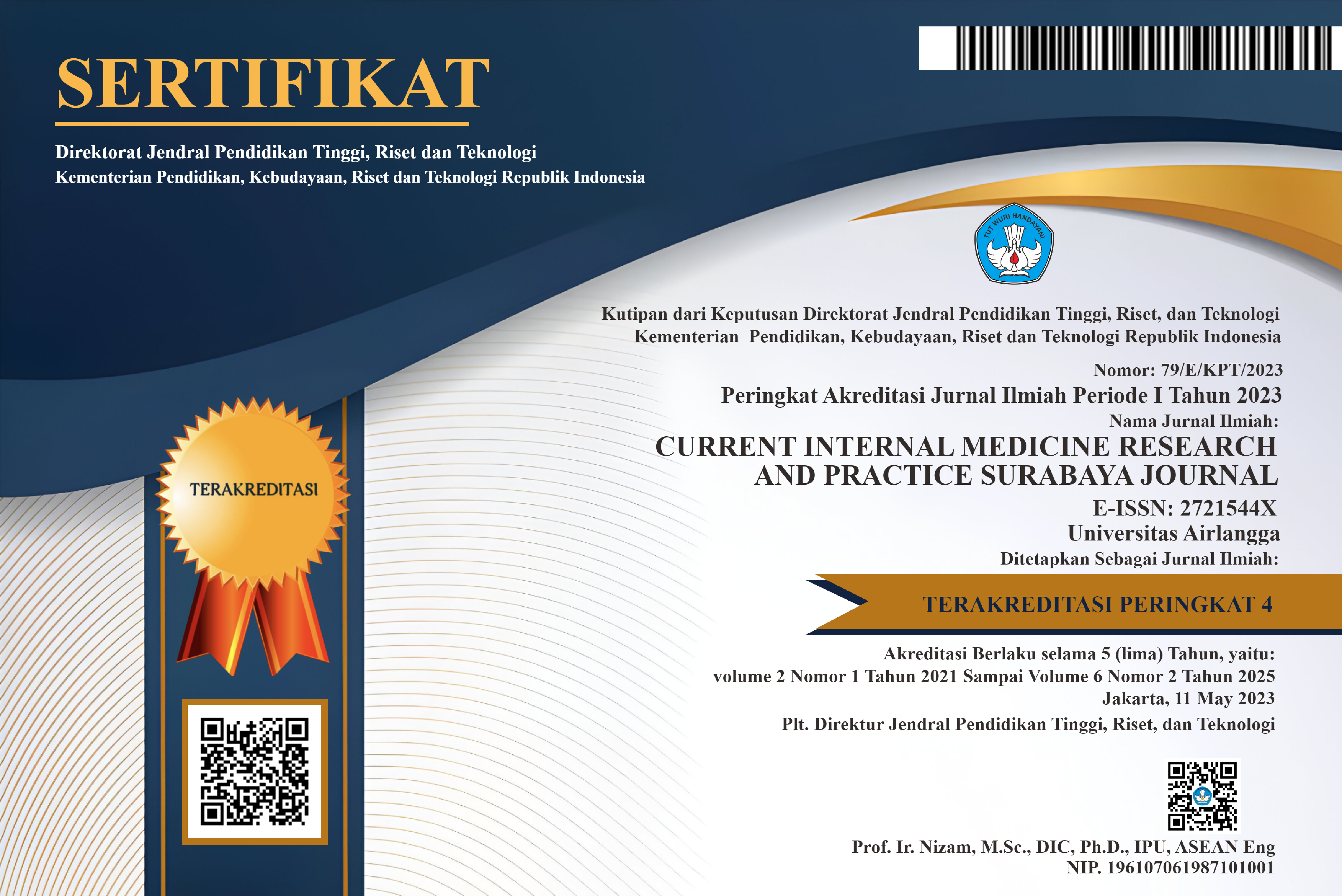Comparative Analysis of Erythrocyte, Leukocyte, and Platelet Indices through Examinations using Sysmex XN-3000 and Yumizen H2500 in Clinical Practice
Downloads
Introduction: Examining erythrocyte, leukocyte, and platelet indices is critical for diagnosis, disease management, therapy selection, and monitoring. It is imperative to evaluate the hematology analyzer used for a complete blood examination, as each device possesses distinct specifications, methods, and technologies. This study aimed to compare complete blood count parameters, specifically the erythrocyte, leukocyte, and platelet indices, using Sysmex XN-3000 and Yumizen H2500.
Methods: This cross-sectional study used blood samples from adult outpatients aged >18 years at Dr. Soetomo General Academic Hospital, Surabaya, Indonesia. Samples were collected using purposive sampling, resulting in 100 blood specimens for complete blood count analysis. The examined variables included erythrocyte, leukocyte, and platelet indices, which were compared across two different instruments, i.e., Sysmex XN-3000 and Yumizen H2500. The data were analyzed using either the Spearman or Pearson correlation test (p<0.05). The Bland-Altman plotting was employed to assess the differences between variables, with a minimum of five agreed-upon outliers.
Results: Significant correlations were observed across all parameters, except for the mean corpuscular hemoglobin concentration (MCHC), which showed limited agreement in the Bland-Altman analysis. The Pearson and Spearman analyses revealed a significant correlation in the parameters of erythrocytes (0.00), leukocytes (0.00), and platelets (0.00). The Bland-Altman plot indicated seven outliers in the average MCHC values from the two analyzers, demonstrating insufficient agreement.
Conclusion: There is significant agreement and correlation in the erythrocyte, leukocyte, and platelet indices from both analyzers. This finding affirms the compatibility of both instruments for clinical use, with caution advised when interpreting MCHC values.
Highlights:
1. This study evaluated the validity of different hematology analyzers for complete blood count examinations in medical laboratories, a topic that has rarely been discussed in detail.
2. The results of this study are expected to contribute to the quality improvement of medical laboratory technologies in Indonesia.
Bararah AS, Ernawati, Andreswari D (2017). Implementasi case based reasoning untuk diagnosa penyakit berdasarkan gejala klinis dan hasil pemeriksaan hematologi dengan probabilitas Bayes. Rekursif Jurnal Informatika 5(1): 43–54. Retrieved from https://ejournal.unib.ac.id/index.php/rekursif/article/view/1074/0.
Berta DM, Grima M, Melku M, Adane T, Chane E, et al. (2024). Assessment of hematology laboratory performance in the total testing process using quality indicators and sigma metrics in the northwest of Ethiopia: A cross‐sectional study. Health Science Reports 7(1): 1–11. doi: 10.1002/hsr2.1833.
Bhola RK, Fudaly C, Rastogi S (2024). A comparative evaluation of performance of Sysmex XN 3000 and Horiba Yumizen H2500 automated complete blood count analysers. Indian Journal of Hematology and Blood Transfusion 40(2): 303–314. doi: 10.1007/s12288-023-01687-6.
Budak YU, Polat M, Huysal K (2016). The use of platelet indices, plateletcrit, mean platelet volume and platelet distribution width in emergency non-traumatic abdominal surgery: A systematic review. Biochemia Medica 26(2): 178–193. doi: 10.11613/BM.2016.020.
Campbell S, Greenwood M, Prior S, Shearer T, Walkem K, et al. (2020). Purposive sampling: Complex or simple? Research case examples. Journal of Research in Nursing 25(8): 652–661. doi: 10.1177/1744987120927206.
Ciepiela O, Kotuła I, Kierat S, Sieczkowska S, Podsiadłowska A, et al. (2016). A comparison of Mindray BC-6800, Sysmex XN-2000, and Beckman Coulter LH750 automated hematology analyzers: A pediatric study. Journal of Clinical Laboratory Analysis 30(6): 1128–1134. doi: 10.1002/jcla.21992.
Cleophas TJ, Zwinderman AH (2018). Bayesian Pearson correlation analysis. In: Modern Bayesian Statistics in Clinical Research. Cham: Springer International Publishing. doi: 10.1007/978-3-319-92747-3_11.
Daves M, Roccaforte V, Lombardi F, Panella R, Pastori S, et al. (2024). Modern hematology analyzers: Beyond the simple blood cells count (with focus on the red blood cells). Journal of Laboratory and Precision Medicine 9: 4. doi: 10.21037/jlpm-23-32.
Giavarina D (2015). Understanding Bland Altman analysis. Biochemia Medica 25(2): 141–151. doi: 10.11613/BM.2015.015.
Gunawardena D, Jayaweera S, Madhubhashini G, Lokumarakkala DD, Senanayake SJ (2017). Reliability of parameters of complete blood count with different storage conditions. Journal of Clinical Laboratory Analysis 31(2): e22042. doi: 10.1002/jcla.22042.
Hidayah L, Sayekti S, Hani IM (2020). Pemeriksaan indeks eritrosit pada ibu hamil dengan anemia (studi di Puskesmas Cukir Jombang). Jurnal Insan Cendekia 7(1): 11–17. doi: 10.35874/jic.v7i1.550.
Horiba Medical (2020). Yumizen H2500/H1500. Retrieved from https://www.horiba.com/int/healthcare/products/detail/action/show/Product/yumizen-h2500-h1500-1856/.
IBM Corp. Released 2017. IBM SPSS Statistics for Windows, version 25.0. Armonk, NY: IBM Corp. Retrieved from https://www.ibm.com/support/pages/downloading-ibm-spss-statistics-25.
Krithikadatta J (2014). Normal distribution. Journal of Conservative Dentistry 17(1): 5–11. doi: 10.4103/0972-0707.124171.
Lippi G, Pavesi F, Bardi M, Pipitone S (2014). Lack of harmonization of red blood cell distribution width (RDW): Evaluation of four hematological analyzers. Clinical Biochemistry 47(12): 1100–1103. doi: 10.1016/j.clinbiochem.2014.06.003.
Maciel TES, Comar SR, Beltrame MP (2014). Performance evaluation of the Sysmex® XE-2100D automated hematology analyzer. Jornal Brasileiro de Patologia e Medicina Laboratorial 50(1): 26–35. doi: 10.1590/S1676-24442014000100004.
Małecka M, Ciepiela O (2020). A comparison of Sysmex-XN 2000 and Yumizen H2500 automated hematology analyzers. Practical Laboratory Medicine 22: e00186. doi: 10.1016/j.plabm.2020.e00186.
Olver P, Bohn MK, Adeli K (2023). Central role of laboratory medicine in public health and patient care. Clinical Chemistry and Laboratory Medicine (CCLM) 61(4): 666–673. doi: 10.1515/cclm-2022-1075.
Pogorzelska K, Krętowska A, Krawczuk-Rybak M, Sawicka-Żukowska M (2020). Characteristics of platelet indices and their prognostic significance in selected medical condition – A systematic review. Advances in Medical Sciences 65(2): 310–315. doi: 10.1016/j.advms.2020.05.002.
Pusparini P, Alvina A (2022). Performance comparison of Dymind DH-76 and Sysmex XN-1000 automated hematology analyzer. Indonesian Journal of Clinical Pathology and Medical Laboratory 28(3): 257–262. doi: 10.24293/ijcpml.v28i3.1907.
Rinawati D, Reza M (2016). Gambaran hitung jumlah dan jenis leukosit pada eks penderita kusta di RSK Sitanala Tangerang tahun 2015. Jurnal Medikes (Media Informasi Kesehatan) 3(1): 99–105. doi: 10.36743/medikes.v3i1.156.
Salman Y, Nadia N, Wahidah R (2021). Differences in leukocyte count result with modified lime juice (Citrus aurantifolia swingle) and vinegar as a substitute for composition of Turk’s solution. The Indonesian Journal of Health 12(1): 12–15. Retrieved from https://journal.stikeshb.ac.id/index.php/jurkessia/article/view/559.
Setiawan A, Suryani E, Wiharto (2014). Segmentasi citra sel darah merah berdasarkan morfologi sel untuk mendeteksi anemia defisiensi besi. ITSMART: Jurnal Teknologi dan Informasi 3(1): 1–8. Retrieved from https://jurnal.uns.ac.id/itsmart/article/view/638.
Sosmira E, Harahap J, Suroyo RB (2021). Analisis kepuasan penggunaan laboratorium klinik di RSUD Sijunjung Sumatera Barat tahun 2019. Journal of Healthcare Technology and Medicine 7(1): 488–501. Retrieved from https://jurnal.uui.ac.id/index.php/JHTM/article/view/1489.
Sysmex Indonesia (2021). XN-3000. Retrieved from https://www.sysmex.co.id/product/xn-3000/?lang=id.
Utami AP, Nurhayati B, Noviar G, Durachim A (2019). Waktu simpan darah antikoagulan K2EDTA dan K3EDTA terhadap parameter eritrosit. Jurnal Riset Kesehatan Poltekkes Depkes Bandung 11(2): 175–189. doi: 10.34011/juriskesbdg.v11i2.743.
Copyright (c) 2025 Yuniar Putri Wardani, Yulia Nadar Indrasari, Putu Niken Ayu Amrita, Muhamad Robi'ul Fuadi

This work is licensed under a Creative Commons Attribution-ShareAlike 4.0 International License.
Copyright (c) Author
1. The journal allows the author to hold the copyright of the article without restrictions.
2. The journal allows the author(s) to retain publishing rights without restrictions.
3. The formal legal aspect of journal publication accessibility refers to Creative Commons Atribution-Share Alike 4.0 (CC BY-SA).






















